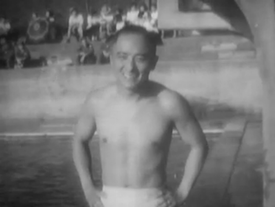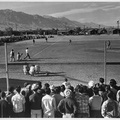Read Part 1 >>
Incidents in Southwood, a suburb just south of San Francisco, and Garden Grove in Orange County demonstrated shifts in public opinion regarding racism toward Asians and Asian Americans. Worried about communists using American housing segregation as a means to discredit U.S. efforts in the Pacific and Far East, Senators like William Knowland and newspaper editors like the San Francisco Chronicle’s Scott Newhall admonished whites to understand how racism played internationally, figuratively stumbling into Russian hands by giving Asians real reasons to wonder about American promises of equality.
For some Asian Americans, blame for these sorts of incidents turned inward. This proved true in segments of the Japanese American community. “The Nisei who is refused a home acts like a scolded dog with tail between his legs and conceals his embarrassment and shame at having been racially rejected so no one else knows about it,” complained JACL Pacific Southwest Regional Director Tats Kushida. “Instead of fighting bigotry, he is encouraging it because the discrimination succeeds by forfeit.” Yet Kushida’s rant could have been directed at his own organization, for the JACL frequently obscured the integration housing efforts of Japanese Americans by failing to publicize the issue.
Nonetheless, urban redevelopment, which displaced L.A. minority populations, and the growing homeowning desires of Japanese Americans led to the JACL’s greater involvement in such issues.
When two time Olympic Gold medalist, Korean American, and Southern California native Sammy Lee attempted to establish a medical practice in Santa Ana, Orange County local doctors disparaged his efforts while realtors refused to sell him a home. Though at times displaying reluctance toward engaging in interethnic and interracial movements, the JACL came to Lee’s aid and after much wrangling Lee secured a home in the area.
While the period from 1943 to 1952 saw the collapse of “urban California’s legal racial hierarchy … residential segregation of all nonwhites persisted.” The dynamics of race emerged sharply altered. The Second Great Migration, historian Josh Sides has noted, brought unprecedented numbers of African Americans to Los Angeles while as pointed out earlier, the Bracero Program and wartime industry needs drew Mexicans North to the city as well.1 The proximity of these racial groups recast race relations, as the perpetual foreigner stereotype that had hounded Asian Americans for decades now became the very reason to support Asian integration: it would send a positive message to future Asian allies in the Far and near East.
Obviously, Japanese internment illustrates a clear correlation between foreign and domestic policies, but postwar housing arguments demonstrate this relationship’s persistence. For example, if Los Angeles’s Japanese Americans suffered internment during the war, American efforts to rebuild Japan along with the valorization of Nisei war service, as later evidenced in films like the noir Crimson Kimono, subsequently provided a direct counterweight to anti-Asian attitudes.
The influx of African Americans also contributed to this shift, as anti-Japanese agitators found their biases overwhelmed by others. “In Los Angeles, which by 1942 was experiencing a massive influx of people of all racial backgrounds, the question quickly lost its immediacy after internment,” Brooks says. “The issue of migration—particularly of blacks and Mexican Americans—completely eclipsed it.”2
San Francisco’s Chinese population—once harshly demonized prior to WWII—also experienced newfound American support. China’s WWII support along with later American military interventions in Asia made treatment of Chinese and Chinese Americans a key Cold War issue.
Brooks points out that this “transnational identity” undermined Chinese claims to national membership, as they were seen as permanent foreigners, albeit welcome ones. Also, as with the Japanese American example, the arrival of larger numbers of African American residents recast white homeowner concerns that now Chinese Americans came to be seen, along with other Asian Americans, as the “model minority,” to be contrasted with more “troublesome” racial/ethnic groups. Accordingly, Brooks suggests that American interventionism in Asia along with pervasive domestic fears of communist infiltration and agitation “spurred white Californians to reconsider the impact of their segregationist decisions. In the end, the deepening Cold War short circuited the emerging pattern and replaced it with a far different one.”3
White homeowners continued to exhibit a desire to live apart from nonwhites; even when they accepted Chinese or Japanese American neighbors, they did so out of a sense of anti-communism rather than any nod toward racial equality. As one white resident, who supported Nisei WWII veteran Sam Yoshira’s attempt to buy a home in Southwood (South San Francisco), commented, “My property values aren’t as important as my principles.”4 Such admissions reveal not only latent racial attitudes but also the effect of FHA/HOLC housing policies that dismissed communities with nonwhites as ineligible for home loans subsidized by the federal government.
Ironically, if early Cold War policies and fears about communism enabled Asian American populations to move away from segregated communities, the emergence of the Vietnam War promoted solidarities with those nonwhites they “had left behind.” Moreover, as Lisa Lowe points out in her groundbreaking 1990s work Immigrant Acts, the very Asian wars that served to reorient Chinese, Japanese, Filipino, and later Vietnamese American citizenship also ruptured each community’s collective memory: “The ‘past’ that is grasped as memory is, however, not a naturalized, factual past, for the relation to that past is always broken by war, occupation, and displacement,” Lowe writes. “Asian American culture ‘re-members’ the past in and through the fragmentation, loss, and dispersal that constitutes the past.”5
The very presence of Asian Americans, whose post WWII population flows directly relate to U.S. military engagement, reminds us of the interventionist (some might argue imperialist) foreign policies that have reshaped American demographics. Under this aegis, Asian American immigration to the US sometimes unfolded under less than ideal circumstances.
In places like Orange County, one forgets that one of the birth places of the New Right and anti-communism now contains 40% of all Vietnamese Americans, a result of refugee resettlement programs. This figure does not even mention the OC’s significant pockets of Chinese and Mexican American minorities. Nor are such circumstances isolated to the West Coast. In Minnesota, Wisconsin, and Michigan, growing Hmong communities have established themselves. Resettled after their allegiance to U.S. forces in the Vietnam War, the Hmong have helped created new urban dynamics in cities like Detroit.

The first Vietnamese-American business center in Little Saigon, Orange County, California. (Photo: Wikipedia.com)
While in his 2008 film, Gran Torino, Clint Eastwood deals with this issue somewhat problematically, the aging director nonetheless demonstrates the nation’s increasing complex racial demographics and how they are sometimes tied not to economic advancement or up-by-the-bootstraps immigrant narratives but rather blowback from U.S. military interventions.
Perhaps consider larger changes in immigration over the past couple of years. East Asian migration to the United States eclipsed Mexican movement North in 2010. With earlier generations coming of age and staking their claim to the nation’s popular culture under the banner of reality shows like K-Town and films like Better Luck Tomorrow, it would seem that understanding the long arc of this population movement behooves us.
“California at mid-century foreshadowed America at century’s end,” Brooks concludes, “a place where race was far more complicated than black and white and where international conflicts affected domestic race relations.”6 Indeed, while California’s tendency to gaze inward, wondering just how it became so awesome, can be frustrating, its early demographics served as harbingers of the America of today. From court cases of the 1940s to Orange County diversity to emerging all-Asian or Latino suburbs of today—like the “Chinese Beverly Hills” of San Marino (or Monterey, depending on your viewpoint) and Mexican American lower middle class South Gate—housing integration hinged on not just race.
Moreover, as Mark Brilliant points out, the extent of housing racism assigned to each group varied. Different groups encountered different forms of racism. No one avenue of redress could serve as a silver bullet for all minorities. Blacks continued to suffer the most egregious discrimination in this regard; so too did Mexican Americans struggle, though again not to the same extent. In the case of Asian Americans, Cold War policies directly intervened and facilitated acceptance into segregated white communities whose residents feared African American neighbors and alienated Asian nation states more so than the average Japanese, Chinese, or Korean American.
Notes:
1. Josh Sides, L.A City Limits: African American Los Angeles from the Great Depression to the Present, (Los Angeles: University of California Press, 2003) pg. 54.
2. Charlotte Brooks, Alien Neighbors, Foreign Friends, pg. 132.
3. Ibid, pg. 193.
4. Ibid, pg. 206.
5. Lisa Lowe, Immigrant Acts: On Asian American Cultural Politics, (Durham, NC: Duke University Press, 1996), pg. 29.
6. Charlotte Brooks, Alien Neighbors, Foreign Friends, pg. 239.
*This article was originally published on TROPICS OF META on November 11, 2013.
© 2013 Ryan Reft






